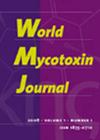在坦桑尼亚达累斯萨拉姆销售的香料中与黄曲霉毒素污染有关的认识、处理和储存因素
IF 2.2
4区 医学
Q3 FOOD SCIENCE & TECHNOLOGY
引用次数: 3
摘要
使用结构化问卷收集了达累斯萨拉姆30家零售商对香料中黄曲霉毒素污染的认识、知识和做法的信息。采用高效液相色谱法(HPLC)和柱后衍生化荧光检测法对香料中的黄曲霉毒素污染进行了分析。对数据进行统计分析,以评估研究社区中与黄曲霉毒素污染相关的因素。58%的香料样品被污染,生姜、肉桂、丁香和豆蔻中的总黄曲霉毒素平均水平分别为2.67、2.88、2.79和2.26μg/kg。绝大多数(96.7%)受访者不知道香料在储存过程中受到黄曲霉毒素污染及其对健康的影响。作为香料采购来源和储存时间超过14天的农民与黄曲霉毒素污染显著相关,比值比(OR)分别为0.178,95%置信区间(CI)为0.061-0.525,P=0.002和OR=3.608,95%可信区间为1.099-11.845,P=0.034。这是坦桑尼亚食用香料中黄曲霉毒素污染的第一份报告。污染程度高,相关香料是从农民那里采购的,储存时间长。这要求在坦桑尼亚紧急提高对预防香料黄曲霉毒素污染的良好管理做法的认识和知识。本文章由计算机程序翻译,如有差异,请以英文原文为准。
Awareness, handling and storage factors associated with aflatoxin contamination in spices marketed in Dar es Salaam, Tanzania
A structured questionnaire was used to collect information of awareness, knowledge and practices associated with aflatoxin contamination in spices from 30 retailers in Dar es Salaam. Aflatoxin contamination in spices was analysed using high performance liquid chromatography (HPLC) with fluorescence detection using post column derivatization. Data were statistically analysed to assess factors associated with aflatoxin contamination in the study community. 58% of the spice samples were contaminated and the mean of total aflatoxin level in ginger, cinnamon, cloves and cardamom was 2.67, 2.88, 2.79 and 2.26 μg/kg, respectively. Significant majorities (96.7%) of the respondents were not aware of aflatoxin contamination of spices during storage and its effect on health. Farmers as source where spices were procured and storage time of more than 14 days showed significant association with aflatoxin contamination with odds ratio (OR) = 0.178, 95% confidence interval (CI) = 0.061-0.525, P=0.002 and OR=3.608, 95% CI=1.099-11.845, P=0.034, respectively. This is the first report of aflatoxin contamination in spices consumed in Tanzania. The levels of contamination are high and associated spices that was procured from farmers and long storage time. This calls for urgent raising of awareness and knowledge on good management practices for prevention of aflatoxin contamination of spices in Tanzania.
求助全文
通过发布文献求助,成功后即可免费获取论文全文。
去求助
来源期刊

World Mycotoxin Journal
MYCOLOGY-
CiteScore
4.60
自引率
5.00%
发文量
25
审稿时长
>12 weeks
期刊介绍:
''World Mycotoxin Journal'' is a peer-reviewed scientific journal with only one specific area of focus: the promotion of the science of mycotoxins. The journal contains original research papers and critical reviews in all areas dealing with mycotoxins, together with opinions, a calendar of forthcoming mycotoxin-related events and book reviews. The journal takes a multidisciplinary approach, and it focuses on a broad spectrum of issues, including toxicology, risk assessment, worldwide occurrence, modelling and prediction of toxin formation, genomics, molecular biology for control of mycotoxigenic fungi, pre-and post-harvest prevention and control, sampling, analytical methodology and quality assurance, food technology, economics and regulatory issues. ''World Mycotoxin Journal'' is intended to serve the needs of researchers and professionals from the scientific community and industry, as well as of policy makers and regulators.
 求助内容:
求助内容: 应助结果提醒方式:
应助结果提醒方式:


